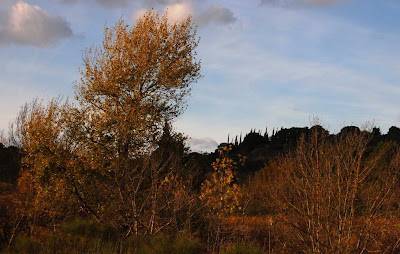If you look at my landscapes you would not, perhaps, consider them as conventional views of nature and the natural environment
Indeed, many of my "landscapes" are quite surreal!
You might be surprised, however, to lean that the above painting of yellow mountains was taken from something I actually saw one foggy morning in the Montaigne Noir
Indeed, much of my work is inspired directly from nature - as was this autumnal view of a rock formation found near Lastours, in the mountains above Carcassonne
I usually take my camera with me on walks in the mountains or in the rolling hills near my village of Montlaur, in the Corbieres (south-west France)
The colours that inspired my landscapes are particularly brilliant here - even in December!
Sunlight, naturally, is essential to catch the range of colours available to an artist closely observing the natural world
However, the exact colour one is searching for is often found in the detail and not necessarily within the larger view
I often work in gouache, enabling me to both work quickly and merge colours and shapes in a very free and sometimes exciting way - I hope!
Sometimes it is possible to create an almost Cubist landscape, merely by using a palette knife on wet gouache liberally applied with a broad brush. Sometimes I work first in black on white paper, then colour it in - like an old fashioned photograph
The pyramid shapes at the base of the picture were created by placing the corner of a shret of A4 paper on the wet paint, then carefully removing it.
It was also inspired by the shape of these mounds of clay found one day when walking in the countryside near Montlaur
For me, texture is all important. I use my camera to explore textures found in nature and apply what I see directly to my work
This little sketch of a lake in the Montaigne Noir was done very quickly on site. The use of conte crayon on rough paper helped capture the texture of the hills surrounding the lake of Pradelle
Later, back in my studio, it became the inspiration for a much larger picture, called After the Flood
Later, back in my studio, it became the inspiration for a much larger picture, called After the Flood
The green in the above picture was actually inspired by a sulphur lake I photographed in New Zealand!
These are the actual colours captured on my camers (Nikon D40), untouched by Photoshop - as is the view (also New Zealand) shown belo:
It often helps to photograph in black and white, thereby enhancing the natural shapes - as in this photograph used to help shape the feathery trees on the horizon of After the Flood
And here is a detail from my finished painting, partially inspired by the above photograph:
Sometimes it is good to work in black and white when actually painting - in my case, liquid graphite applied with a thick brush then shaped using a palette knife. You have to work very fast but the effect can sometimes be quite striking.
Take this study of a small wood, for example:
This image was partly inspired by photographs taken on a walk in the woods near where I live. Its not, though, a matter of copying nature but of capturing mood, shape and texture
I also use a technique first developed by the Surrealists - it involves pressing paper onto wet gouache then removing it carefully - leaving strange and often beautiful shapes and textures
This technique was used on the small mountain landscape shown below:
Sometimes, a picture using this technique can be enhanced by the addition of photographic material. In the little picture shown below I have added clouds to give it depth
Again, photographs helped devise the rock surfaces that appear in many of my landscapes.
For example, in southern France and Spain the mountains are limestone and often provide extraordinary natural shapes, carved by the wind and rain
For example, in southern France and Spain the mountains are limestone and often provide extraordinary natural shapes, carved by the wind and rain
 |
| Photo by Mitch Phillips |
Actual textures require closer observation and in this case I made detailed drawings on site, usually in pencil or charcoal
Often I try to combine a number of such techniques in one painting - as in this study of trees, corn fields and rocks under a harvest moon:
Finally, it is possible to obtain interesting surface detail with mixed media
In the example given below I have added bleach to wet graphite on paper. This little picture is called Enchanted Wood and shows how the bleach has affected the wet graphite, creating strange shapes and patterns and textures
In the example given below I have added bleach to wet graphite on paper. This little picture is called Enchanted Wood and shows how the bleach has affected the wet graphite, creating strange shapes and patterns and textures
It has also turned it brown!
Here below is a detail from a similar picture, clearly showing the way the bleach has transformed areas of wet graphite on very white paper
The disadvantage, of course, of using bleach is that eventually your picture turns brown and then perhaps even disappears!
Finally, many of the techniques shown above can be applied to a larger composition, something that may have its origins in nature but which has become a far more considered, mediated image - as in my painting called Rainbow Forest
By the way, this painting is gouache and varnish on canvas - an unusual combination. The white swirl in the middle was added using acrylic paint, shaped with my index finger. Cool, eh?!
Keep painting!

























No comments:
Post a Comment